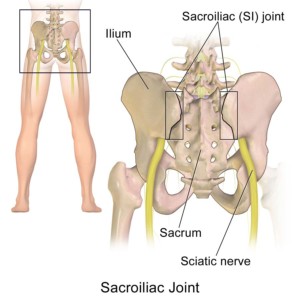What is Sacroiliac Joint Pain?

The sacroiliac (SI) joint can cause pain in the low back or buttocks. This is especially common in women, and often radiates into the leg, masquerading as sciatica. Sacroiliac joint pain generally responds well to non-steroidal medications and physical therapy. Occasionally, injections into or around the sacroiliac joint space are necessary to completely alleviate the pain and dysfunction and clarify the diagnosis.
Related Articles:
Sacroiliac joint injections are used to either diagnose or treat low back pain thought to be due to sacroiliac joint dysfunction.
There are two sacroiliac joints, one on the each side. The joints are below the lumbar spine and connect the sacrum (tailbone) to the pelvis (hips). Two types of Injections can be performed to the SI joint, to either diagnose or treat SI joint pain. A diagnostic injection will generally only include a numbing medication. A therapeutic injection will contain both a numbing agent and a corticosteroid (cortisone-like anti-inflammatory medication).
Lateral branch blocks as a treatment for sacroiliac joint pain.
Pain arising from the sacroiliac (SI) joint is a common cause of low back pain for which there is no universally accepted, long-term treatment. Previous studies have shown radiofrequency (RF) procedures to be an effective treatment for other types of spinal pain. The purpose of this study was to determine the efficacy of reducing SI joint pain by percutaneous RF lesioning of the nerves innervating the SI joint.


